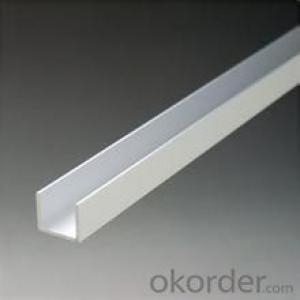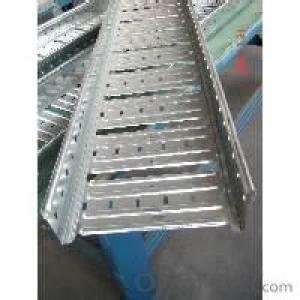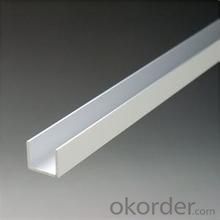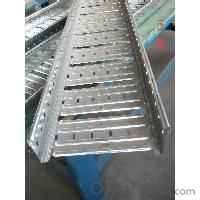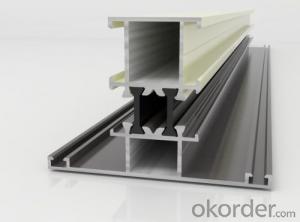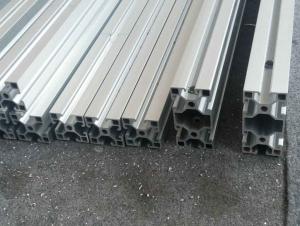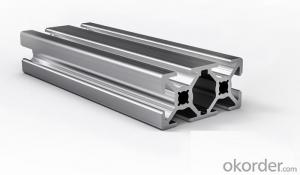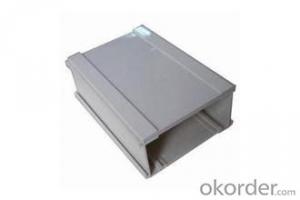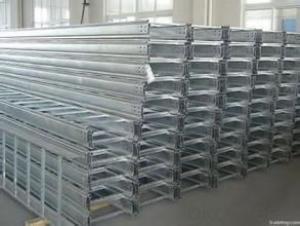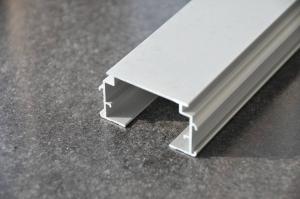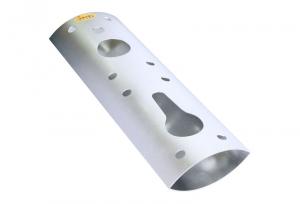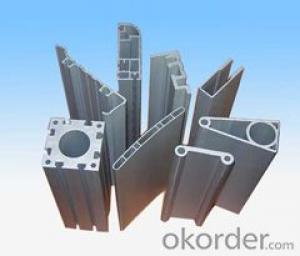Aluminum Window Extrusion Profiles Section H Cable Tray
- Loading Port:
- China Main Port
- Payment Terms:
- TT OR LC
- Min Order Qty:
- -
- Supply Capability:
- -
OKorder Service Pledge
OKorder Financial Service
You Might Also Like
Aluminium is a relatively soft,durable, lightweight, ductile and malleablemetal with appearance ranging from silvery to dull gray,depending on the surface roughness. It is nonmagnetic and does not easilyignite. A fresh film of aluminium serves as a good reflector (approximately92%) of visible light and an excellent reflector (as much as98%) of medium and far infrared radiation. The yield strength of pure aluminium is 7–11 MPa,while aluminium alloys have yield strengths ranging from200 MPa to 600 MPa. Aluminium has about one-third the density and stiffnessof steel. It iseasily machined,cast, drawn and extruded.
Alu Profile:
Material | Alloy 6063,6061,6005or according to customer’s choice |
Temper | T3, T4, T5, T6 |
Surface | Anodize, electrophoresis, powder coating, PVDF coating, wood grain painting, matted, etc. |
Length | Coating 6.5 meters, Anodizing 6.5 meters, Mill finish 5 meters |
Application | Industrial, electrical equipment(TV set, air conditioner, refrigerator, computer), decoration,construction, transportation |
Custom Made | We can package following with customer's request. |
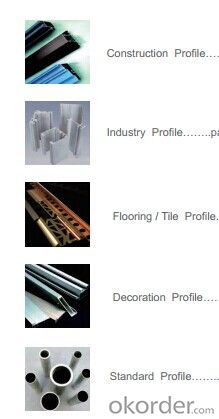
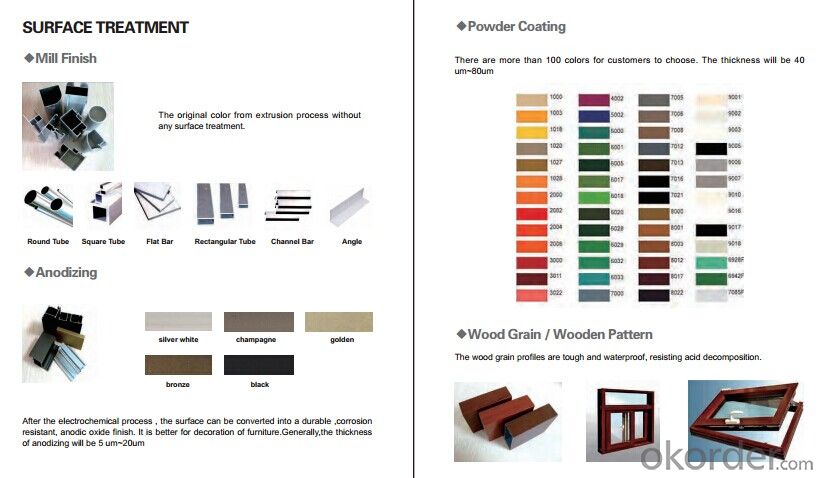
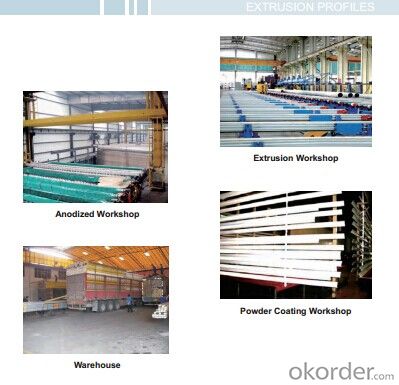
FAQ:
1. What is the form of payment?
Normally 30% TT, L/C at sight
2. Type of quotation?
FOB, CFR, CIF
3. Port of loading?
Guangzhou/Shenzhen port
4. Delivery time?
15-20 days after client’s deposit
- Q: Are aluminum profiles suitable for modular construction?
- Aluminum profiles are an excellent choice for modular construction due to their many advantages. Not only are they lightweight, but they also possess considerable strength, making them perfect for supporting heavy loads in modular buildings. This structural integrity ensures the safety and stability of the entire structure. Additionally, aluminum profiles are resistant to corrosion, which is essential for modular construction projects that may face various weather conditions. This resistance enhances the durability and lifespan of the modular constructions, ultimately reducing maintenance costs in the long term. Moreover, aluminum is highly versatile and can be easily shaped and sized to meet specific design requirements. This adaptability allows architects and engineers to create innovative and functional modular structures tailored to each project's needs. Furthermore, the lightweight nature of aluminum profiles makes them easier to transport and handle during the construction process, compared to traditional building materials like steel. This lightness also helps reduce the overall weight of the modular constructions, resulting in cost savings for transportation and foundation requirements. Additionally, aluminum is a sustainable material, as it is entirely recyclable and requires less energy to produce compared to other materials. This environmentally friendly aspect aligns with the increasing demand for sustainable building practices, making aluminum profiles an ideal choice for modular construction projects. In conclusion, aluminum profiles offer numerous advantages that make them highly suitable for modular construction. Their strength, resistance to corrosion, versatility, lightweight nature, and sustainability all contribute to creating durable, customizable, and efficient modular structures.
- Q: Are there any specific regulations or standards for using aluminum profiles in certain industries?
- Yes, there are specific regulations and standards for using aluminum profiles in certain industries. These regulations and standards vary depending on the industry and the specific application of the aluminum profiles. They are in place to ensure the quality, safety, and performance of the profiles in various industries such as construction, automotive, aerospace, and manufacturing. Compliance with these regulations and standards is essential to meet industry requirements and ensure the proper use of aluminum profiles.
- Q: What are the different anodizing colors available for aluminum profiles?
- There are several different anodizing colors available for aluminum profiles, including clear, black, bronze, gold, and champagne.
- Q: Are aluminum profiles suitable for high-traffic areas?
- Yes, aluminum profiles are suitable for high-traffic areas. Aluminum is a durable and lightweight material that can withstand heavy use and frequent movement. It is resistant to corrosion and can maintain its structural integrity even in high-traffic environments. Additionally, aluminum profiles can be designed to meet specific safety and aesthetic requirements, making them an ideal choice for areas with a large volume of foot traffic.
- Q: Are aluminum profiles suitable for industrial workstations?
- Yes, aluminum profiles are suitable for industrial workstations. Aluminum is a lightweight and durable material that provides excellent strength and stability, making it ideal for use in industrial settings. It has high corrosion resistance, which helps to prolong the lifespan of the workstations. Additionally, aluminum profiles can be easily customized and assembled, allowing for flexibility and adaptability in designing the workstations to meet specific industrial needs. The material is also environmentally friendly, as it is 100% recyclable, which aligns with the growing emphasis on sustainability in the industrial sector. Overall, aluminum profiles offer numerous advantages for industrial workstations, making them a suitable choice for various applications in industrial settings.
- Q: The aluminum and Fenglv aluminum material which is better suited for doors and windows
- PS: the selection of aluminum window into just half the decision factors, installation of doors and windows have a direct impact on the quality and life of your Windows, strictly speaking, the selection of aluminum should consider responding to a lot, such as climate, suitable for aluminum electrophoresis in coastal areas, because of its resistance to alkali corrosion inhibition; inland area selection spraying aluminum, its color is very rich in Beijing, multiselect bridge aluminum (considering energy saving and environmental protection, economic factors), domestic manufacturers of aluminum is uneven, price 2000~3000 yuan per ton is normal, because of the large manufacturers to something that is of good quality, with purity aluminum extrusion, the cross section of silver, customer service there are many security, the black heart of the small manufacturers (including some large manufacturers) will add different amounts of time in the production of aluminum, in order to offset part of the pure aluminum ingot, manufacturing
- Q: Can aluminum profiles be used in green building projects?
- Yes, aluminum profiles can be used in green building projects. Aluminum is a highly sustainable material as it is 100% recyclable and has a low carbon footprint. Additionally, aluminum profiles offer various benefits such as durability, versatility, and energy efficiency, making them suitable for green building practices.
- Q: Regarding the wall thickness of aluminum alloy profiles, are there any standards in the country?
- For the main force components of aluminum alloy curtain wall, such as column, transverse material and so on. Such as closed hollow profiles, the wall thickness of not less than 3mm, if the solid section (or known as non closed profiles), the wall thickness of not less than 2.5mm. The state has standards for curtain walls.
- Q: How is the thickness of the base plate of the aluminum profile radiator calculated? Are there formulas for calculation?
- There should be empirical formula, the heat of the surface heat dissipation is related to thermal conductivity, thickness, temperature change, surface area. Then the best thickness is calculated by linear programming.
- Q: 30*40 how much aluminum meter?
- 3040 aluminum price, looking for Shanghai Bei pie. Aluminum specifications are complete, the corresponding parts are.
Send your message to us
Aluminum Window Extrusion Profiles Section H Cable Tray
- Loading Port:
- China Main Port
- Payment Terms:
- TT OR LC
- Min Order Qty:
- -
- Supply Capability:
- -
OKorder Service Pledge
OKorder Financial Service
Similar products
Hot products
Hot Searches
Related keywords
